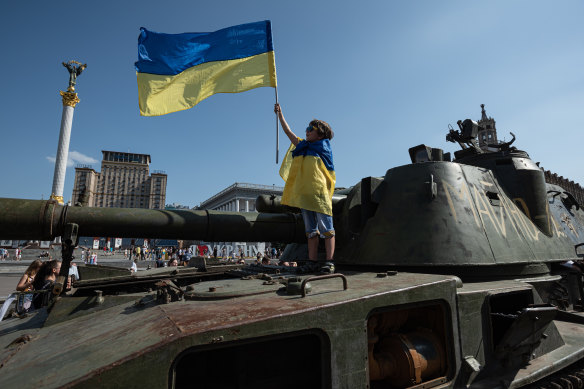
Part of its first push came in a July, to support a fund-raising effort for the Georgian National Legion fighting the Kremlin’s forces in Ukraine. (Georgia in 2008, like Ukraine this year, was attacked by neighbour Russia.)
The ubiquitous Shiba Inu dogs – which symbolise NAFO – now appear almost wherever there is talk of the Russian-Ukraine war on social media ... especially when the talk comes from a Russian source.
The furry faces give partisans supporting Ukraine a meme to apply to Russia’s voluminous messaging on social media and elsewhere, to subvert it, to dilute it and weaken it.
“It has hampered Russia’s propagandists and made them look absurd and ridiculous in the process,” Oz Katerji, a British-Lebanese journalist, tells The Age and Sydney Morning Herald.
The NAFO community is comprised of a recognisable group of pro-Ukraine analysts, journalists and activists who are pushing back against Russian disinformation, Katerji says.
“By all of us clubbing together, and providing a fun and inclusive opportunity for regular people to join in, it has driven the movement and made it go viral.”

As the war in Ukraine expands, it expands deeper into social media: Rising smoke seen from the beach at Saky after explosions at a Russian military airbase near Novofedorivka, Crimea this month.Credit:AP
There is history here, too.
In the past decade, the Kremlin’s skilful use of memes, bots, and co-ordinated trolling helped it sow chaos among democracies. Russia used its same propaganda tools to protect the Syrian regime of leader Bashar al-Assad as it waged a bloody war on its own citizens.
Katerji, who covered the Syrian war, notes the difference between Russia’s information war on Syria and the one on Ukraine, which it invaded in February.
“To better understand NAFO you need to compare it with their Syria propaganda, which would often go viral and receive virtually no pushback. What was once an effective disinfo’ op is now struggling to make the same impact in Ukraine,” he says.

A boy holds a Ukrainian flag atop a Russian tank displayed in Kyiv ahead of Independence Day.Credit:Getty
Taking up the Shiba Inu, a visual cousin to previous memes, has become a proxy for people, particularly those far from the battlefield to, well, pitch in.
NAFO is “almost like an in-joke that anyone can be a part of,” Katerji said. “It has required no motivation on our part.”
The phrase “You pronounced this nonsense” is a related meme.
Loading
It comes from a Russian diplomat who, fending off what he thought were pro-Ukrainian bots on Twitter in June, was actually communicating with a pro-Ukrainian meme army ... masquerading, of course, as partisan Shiba Inus.
“NAFO vs Russian ambassador Mikhail Ulyanov was one of the loudest things on Twitter,” said
Eto Buziashvili.
The Russian ambassador lied, the fellas exposed it, the ambassador engaged with them, and he lost.
“Basically, Shiba Inu doggos were chasing [the] Russian ambassador,” said Buziashvili, who estimates there are “thousands, if not tens of thousands, of fellas on Twitter already”.
This isn’t the first time small, adorable avatars have taken on Russia’s info warriors online.
Following Russia’s 2014 invasion of Ukraine, Lithuanians created an army of elves to counter Russian propaganda on social media.
“Like Lithuanian elves, fellas are fighting disinformation online and they self-organised following Russia’s re-invasion of Ukraine.”
What Buziashvili calls the “impressive movement of decentralised volunteers” uses “humour and memes to debunk and fight Russia’s disinformation and propaganda.”
“They are funny, smart, and their logos of Shiba Inu doggos are just adorable.”
University of Sydney lecturer in Digital Cultures Olga Boichak said #NAFO refutes the idea that such online movements are simply “clicktivism”, or a kind of surface-level communication with little real-world impact.
In the past decade, a pertinent question among media academics was the extent to which support for causes on social media translates into tangible outcomes to “affect a cause people care about”.
These fellas “unsettle this [obsolete] understanding of online activism”, Boichak said because they work not just to mobilise people in the information realm, but also raise funds to supply troops in the field.
NAFO fellas have so far raised at least $US50,000 for the Georgian Legion, Know Your Meme website reported. There are other campaigns as well, such as supplying medical and tech equipment to the Ukrainian military, another focuses on sending drones. One fella even creates and distributes fella avatars for donations to the Georgia Legion.
Boichak described the rise of #NAFO as an example of “participatory warfare”, which can “directly or indirectly influence the outcome of a military conflict on the ground”.
And the name, NAFO.
North Atlantic Fella Organisation is a play on NATO, the real-world North Atlantic Treaty Organisation, which dates back to 1949 and was (really) created to defend Europe from an expansionist Russia.
NAFO, however, with dancing dogs, cheeky captions, and viral catchphrases is a product of our time.
And so, as real war unfolds in Ukraine, NAFO’s expansion continues through the internet, one Shiba Inu at a time.









 Add Category
Add Category